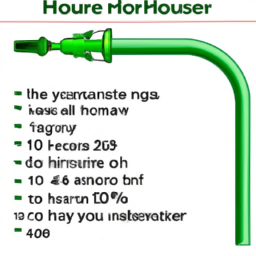Garden Hose How Many GPH
How Many Gallons Per Hour Garden Hose
How Many Gallons Per Hour a Garden Hose Can Produce - An In-Depth Guide
Having the right tools and knowledge to take care of your garden makes for an enjoyable hobby. That can include learning nuts and bolts of your garden hose's capabilities, like how many gallons per hour it can transfer.
Features of a Garden Hose
A garden hose typically consists of three components: the inner tube, the reinforcement layer, and the outer shell. The inner tube is made of materials that are resistant to corrosion and abrasion, as it carries the water throughout the hose.
The reinforcement layer - typically layers of fabric - give the hose energy and its outer layer can be made of plastic, polyester, or rubber. It can also strengthen the inner tube, depending on the material.
Benefits of a Garden Hose
Garden hoses are designed to be used for a variety of purposes depending on the length and material of the garden hose. They are lightweight, flexible and can be used for watering plants, filling up a pool or even washing a car.
Garden hoses are designed to be easy to store, easy to carry, and simple to use. They are an essential gardening tool for anyone who wants to take care of a garden.
Pros & Cons of Using Garden Hoses
Pros:
- Garden hoses are lightweight and portable so they are easy to carry from one place to another.
- They are made of materials that can withstand daily wear and tear.
- The length of garden hoses can be modified depending on how much water you need.
Cons:
- Garden hoses are not as durable as other hoses and can be easily worn down by sharp objects.
- The material of the hose can burst or become punctured if the water pressure is too high.
Case Studies
Case Study 1: Naomi, an avid gardener, needed to water her plants, but her plastic garden hose wasn't enough. She decided to invest in a garden hose that was longer and stronger, specifically an expandable metal hose.
She found that the metal hose was more durable and less prone to punctures than her plastic hose. Additionally, she was able to measure the water output using a flow meter to ensure that her plants were watered evenly and efficiently.
Case Study 2: John had a big garden and needed to get water to all parts of his lawn quickly. He decided to invest in a polyester reinforced rubber garden hose.
He discovered that the polyester reinforced rubber hose was more resistant to abrasions and was able to carry the water farther and faster than he expected. Additionally, the hose material was able to withstand higher water pressure, allowing him to use more water at once.
FAQs
Q: How do you measure water output in gallons per hour from a garden hose?
A: To measure water output, you will need a flow meter. Attach the flow meter to the end of your garden hose, and then use it to measure the water output from the hose in gallons per hour.
Q: How many gallons of water can be released from a garden hose in an hour?
A: The amount of water that can be released from a garden hose in an hour will depend on the length and material of the hose. A typical garden hose will be able to release up to 120 gallons of water per hour.
Mistakes People Make When Using Garden Hoses
- Not checking garden hoses for signs of wear and tear. This will lead to the hose bursting or becoming punctured.
- Using the garden hose with too much water pressure, which can lead to the material of the hose becoming damaged over time.
- Not investing in a garden hose with a longer length or a stronger material, which will limit the amount of water that can be released from the hose.
Best Practices for Using Garden Hoses
- Always inspect garden hoses for signs of wear and tear before using them.
- Invest in a garden hose with a longer length or stronger material depending on the job.
- Use aflow meter to measure how much water is flowing from the garden hose.
- Use the garden hose with the appropriate water pressure for the material of the hose.
Summary
Garden hoses can be used for a variety of purposes, such as watering plants, filling up a pool, and washing a car. It's important to keep in mind the features, benefits, pros and cons, case studies, FAQs, mistakes people make, and best practices when using a garden hose.
When using a garden hose, it's important to always check for signs of wear and tear, invest in the right length and material, use a flow meter to monitor the water output, and use the proper water pressure for the hose material. With this knowledge and the right tools, gardening can be an enjoyable and rewarding hobby.

Previous Page
Next Page
